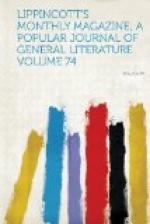In the second part, comprising Poets chiefly before Dante, we have specimens of the Sicilian school—a canzone by the great Frederick, and a sonnet by his luckless son Enzo, who died in prison at Bologna after a confinement of nearly twenty-three years. Of more importance are the poems of Guido Guinicelli, of which the philosophical one entitled “Of the Gentle Heart” was a nine days’ wonder, but which, even in Rossetti’s elegant version, seems cold and formal. The most natural and pleasing pieces among much that is artificial and conventional are a ballad and two “catches” by Sacchetti, who died just after 1400, and properly does not belong to Dante’s circle. Mr. Rossetti’s readers will, however, be grateful to him for his delightful versions of the two catches, one “On a Fine Day,” the other “On a Wet Day,” giving the experiences of a band of young girls who have gone to spend the afternoon in the fields and are overtaken by a shower.
Poems like these, unfortunately, are rare. The range is a limited one—Platonic love in its conventional form, or the still more conventional form of chivalric love, imported bodily from the Troubadours. Scattered here and there are some noble poems; as, for instance, the one attributed to Fazio degli Uberti on his lady’s portrait, which begins—
I look at the crisp golden-threaded hair,
Whereof, to thrall my heart, Love twists
a net;
Using at times a string of pearls for
bait,
And sometimes with a single rose therein.
Mr. Rossetti has performed his task in a way to deserve the warmest praise. The difficulties he has overcome are very great, consisting not merely of intricate rhyme and assonance, which he has faithfully reproduced, but a text often corrupt and meaning often obscure. He says himself in his preface that “The life-blood of rhythmical translation is this commandment—that a good poem shall not be turned into a bad one;” and this commandment, as far as we can see, he has not broken in a single case, while in some instances, we are bold enough to say, the translation is better than the original.
History of the Army of the Cumberland, its Organization, Campaigns and Battles. Written at the request of Maj.-Gen. George H. Thomas, chiefly from his private military journal and other official documents furnished by him. By Thomas B. Van Horne, U.S. Army. Illustrated with campaign and battle maps compiled by Edward Ruger, late Superintendent Topographical Engineer Office, Head quarters Department of the Cumberland. 2 vols. and atlas. Cincinnati: Robert Clarke & Co.
It was natural that General Thomas should make choice of some one to whom he could entrust the task of writing his military history. For that purpose he chose Mr. T.B. Van Home, a chaplain in the regular army, and the work, which was begun in 1865 and finished in 1872, was subject to Thomas’s own examination. The result is now, after this long delay, presented




